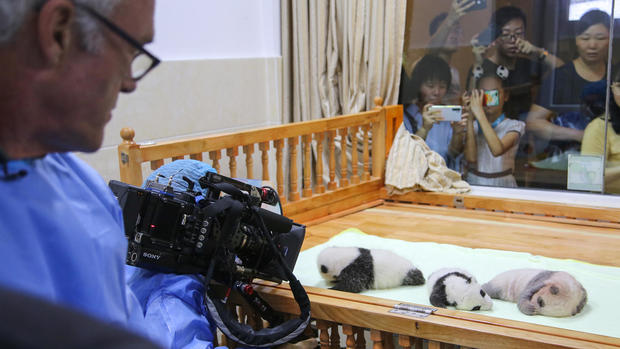Giant pandas: What does it take to raise a baby panda in captivity?
For scientists to bring giant pandas back from the edge of extinction, they first had to figure out how to keep the tiniest pandas alive.
This week on 60 Minutes, correspondent Scott Pelley travels to China's Chengdu Panda Base to get an up-close look at how they do it.
"What we found—that it takes a lot of work to raise a baby panda," said 60 Minutes producer Nicole Young, who produced this week's piece with associate producer Katie Kerbstat. "And human help and the human touch is why they've been able to help bolster, help boost the giant panda population in captivity."
Because the panda gestation period is generally short, baby pandas are small, weighing only a few ounces and measuring the size of a stick of butter. Newborn pandas are pink, hairless, and unable to open their eyes for weeks.
Scientists at the base granted Pelley rare access into their panda nursery to get a close look at these vulnerable cubs. Mindful of spreading germs and disease, Pelley and his cameramen had to dress head-to-toe in hospital scrubs. "These bears are completely helpless when they're born," Pelley said. "And so they were concerned about any human virus that might affect them, any kind of bacteria that we might bring in."
Many giant panda mothers have twins, but scientists found that, in the wild, the smallest twin would be left to die. Panda mothers' limited diet of bamboo does not provide enough energy to produce milk for both cubs—and that's where human caretakers at the Chengdu Panda Base step in.
In the nursery, veterinarians mimic the behavior of the giant panda mother, supplementing feeding time with formula in a bottle. When the mother is able to breastfeed, they hand the baby cub back to her, alternating between the two cubs for several hours each day.
The base seems to have mastered how to rear panda cubs. Veterinarians have delivered five cubs in 2019, with remarkable success—just about every cub born at the base now survives.
The achievement has helped to boost the overall number of pandas on the globe. In 2016, the giant panda's conservation status was upgraded from endangered to just vulnerable.
"It's really one of the greatest conservation efforts known to man," Young said.
To watch Scott Pelley's report on giant pandas, click here.
The video above was originally published on October 27, 2019, and produced by Brit McCandless Farmer, Will Croxton, and Matthew Polevoy. It was edited by Will Croxton.






